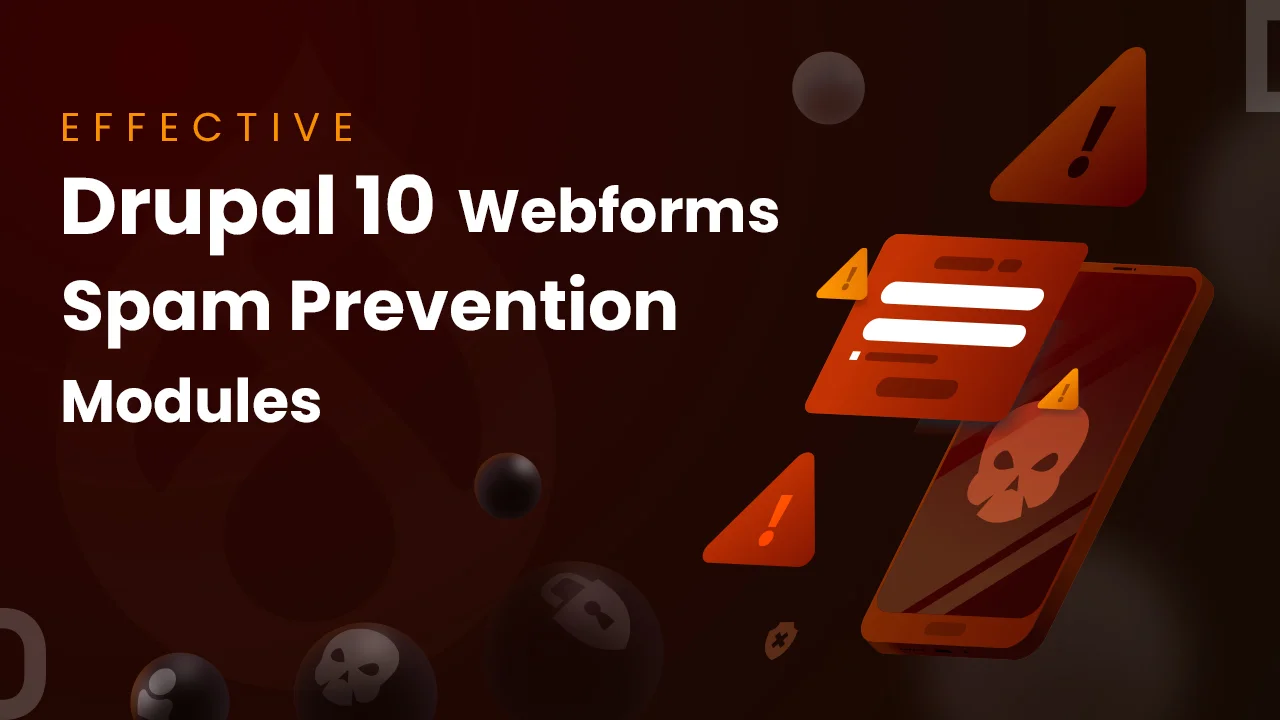Do you love webforms? We do too!
Webforms are a great way to collect information, feedback, and opinions from your site visitors.
They can help you improve your products, services, and user experience along with generating leads, conversions and sales.
But there is one thing that we don’t love about webforms – spam.
Spam is an unwanted and unsolicited submission that clog up your webforms and waste your time and resources.
Spam can also harm your site’s performance, security, and reputation. It can come from bots or fraudulent users who want to spam your site with ads, links or junk content.
How can you stop spam from ruining your webforms and your site?
How can you certify that only genuine and relevant submissions are accepted and processed?
How can you protect your site and your users from spam attacks?
Drupal is a powerful and flexible CMS that allows you to create and manage webforms for various purposes, such as contact forms, surveys, quizzes, and more. However, webforms can also attract unwanted spam submissions from bots or malicious users, which can affect your site’s notoriety.
How can you prevent spam on your Drupal webforms and make sure of a smooth and safe user experience?
Here, our cmsMinds experts will take you to explore some of the best Drupal modules that can help you combat spam on your webforms. These modules use different techniques and technologies to detect and block spam submissions, such as hidden fields, CAPTCHA challenges, JavaScript validation, IP filtering, and more. We will also look at some of the benefits and drawbacks of each module, and how to install and configure them on your Drupal site.
Spammaster: Multi-Technique Spam Filter Module for Diverse Drupal Forms
Spammaster is a versatile Drupal module that uses multiple spam detection techniques to filter out unwanted submissions.
The Spammaster module integrates with various spam detection services and technologies, such as reCAPTCHA, Honeypot and Akismet.
These services help analyze and identify spam submissions based on factors like IP reputation, known spam patterns, and user behavior.
Some of the features of Spammaster are:
- It can block spam submissions on webforms, comments, user registrations, contact forms, and more.
- It can automatically delete spam submissions or mark them as spam for manual review.
- It can display a custom message or redirect the user to a different page when spam is detected.
- It can log and report spam statistics and activity on your site.
- It can whitelist or blacklist specific IP addresses, domains, or keywords.
To install and use Spammaster, you need to:
- Download and enable the module on your Drupal site.
- Go to Configuration > Spammaster and enter your API keys for the spam detection services that you want to use.
- Go to Configuration > Spammaster > Settings and adjust the settings according to your preferences.
- Go to Configuration > Spammaster > Protection and enable the protection for the forms that you want to protect from spam.
Honeypot: Invisible Field-Based Bot Deterrent for Drupal Webforms
Honeypot is a lightweight and effective Drupal module that adds hidden form fields to webforms. These fields are invisible to human users but are filled in by spam bots.
When these fields are detected as filled, the submission is considered spam and rejected.
Honeypot acts as a deterrent for spam bots without bothering legitimate users with CAPTCHA challenges.
Some of the features of Honeypot are:
- It can protect any form on your Drupal site, including webforms, comments, user registrations, contact forms, and more.
- It can use a time limit to check how long it takes for a user to fill out a form. If the time is too short or too long, the submission is considered spam.
- It can use a custom field name and value for the hidden field to make it less obvious for spam bots.
- It can log and report spam statistics and activity on your site.
To install and use Honeypot, you need to:
- Download and enable the module on your Drupal site.
- Go to Configuration > Content authoring > Honeypot and adjust the settings according to your preferences.
- Go to Configuration > Content authoring > Honeypot > Form protection and enable the protection for the forms that you want to protect from spam.
Antibot: JavaScript-Enhanced Bot Detection Solution for Drupal Sites

Antibot is another useful Drupal module that utilizes JavaScript-based techniques to detect and block automated bots. It adds a simple question to the webform that is easy for humans to answer but challenging for bots.
For example, it may ask users to perform a simple calculation or choose the correct image from a set of options. By distinguishing between human and bot behavior, Antibot effectively thwarts spam attacks.
Some of the features of Antibot are:
- It can protect any form on your Drupal site, including webforms, comments, user registrations, contact forms, and more.
- It can use different types of questions, such as math, image, text, or custom.
- It can use a random or fixed question for each form or each submission.
- It can display a custom message or redirect the user to a different page when spam is detected.
- It can log and report spam statistics and activity on your site.
To install and use Antibot, you need to:
- Download and enable the module on your Drupal site.
- Go to Configuration > System > Antibot and adjust the settings according to your preferences.
- Go to Configuration > System > Antibot > Form protection and enable the protection for the forms that you want to protect from spam.
reCAPTCHA: Advanced Google-Powered CAPTCHA Integration for Drupal Security
reCAPTCHA is a widely recognized and powerful spam prevention tool provided by Google. The Drupal module integrates reCAPTCHA’s advanced capabilities into your webforms.
It uses complex challenges, such as image recognition or checkbox verification, to differentiate between human users and bots. With reCAPTCHA, you can add an extra layer of security to your forms and make sure that only genuine submissions are accepted.
Some of the features of reCAPTCHA are:
- It can protect any form on your Drupal site, including webforms, comments, user registrations, contact forms, and more.
- It can use different types of challenges, such as reCAPTCHA v2, reCAPTCHA v3, or Invisible reCAPTCHA.
- It can use a custom theme, size, and language for the reCAPTCHA widget.
- It can display a custom message or redirect the user to a different page when spam is detected.
- It can log and report spam statistics and activity on your site.
To install and use reCAPTCHA, you need to:
- Download and enable the module on your Drupal site.
- Go to Configuration > People > CAPTCHA and enter your site key and secret key for the reCAPTCHA service that you want to use.
- Go to Configuration > People > CAPTCHA > Form protection and enable the protection for the forms that you want to protect from spam.
Protect Form Flood Control: Submission Rate Limiting Module for Drupal Form Protection
Protect Form Flood Control is a Drupal module that limits the number of submissions that a user can make on a webform within a certain time period. This helps prevent spam attacks that try to flood your site with multiple submissions from the same IP address or user account.
The module also allows you to set different limits for anonymous and authenticated users, and for specific forms or roles.
Some of the features of Protect Form Flood Control are:
- It can protect any form on your Drupal site, including webforms, comments, user registrations, contact forms, and more.
- It can use different types of limits, such as per IP address, per user, per form, or per role.
- It can use different time intervals, such as per hour, per day, per week, or per month.
- It can display a custom message or redirect the user to a different page when the limit is reached.
- It can log and report spam statistics and activity on your site.
To install and use Protect Form Flood Control, you need to:
- Download and enable the module on your Drupal site.
- Go to Configuration > System > Protect Form Flood Control and adjust the settings according to your preferences.
- Go to Configuration > System > Protect Form Flood Control > Form protection and enable the protection for the forms that you want to protect from spam.
Spam is a common and annoying problem for any website that uses webforms. Fortunately, Drupal offers a variety of modules that can help you prevent spam on your webforms and ensure a smooth and safe user experience.
If you are looking for a professional and reliable Drupal development company in Raleigh, we have a team of experienced and certified Drupal developers who can help you with any Drupal project, from headless Drupal development to Drupal 10 development along with Drupal migration, Drupal maintenance, Drupal security and Drupal SEO.



